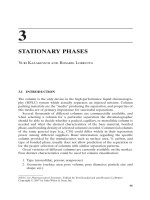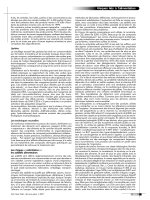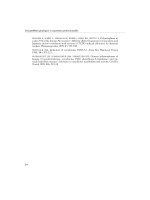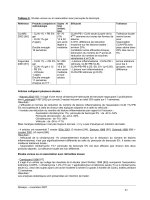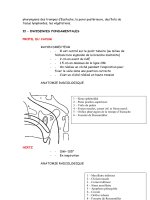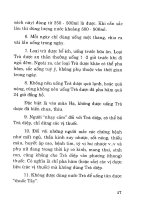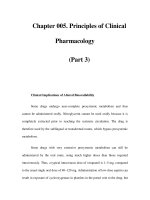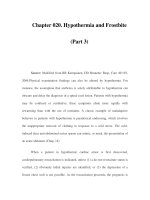Chapter 021. Syncope (Part 3) doc
Bạn đang xem bản rút gọn của tài liệu. Xem và tải ngay bản đầy đủ của tài liệu tại đây (57.08 KB, 5 trang )
Chapter 021. Syncope
(Part 3)
Situational Syncope
A variety of activities, including cough, deglutition, micturition, and
defecation, are associated with syncope in susceptible individuals. Like
neurocardiogenic syncope, these syndromes may involve a cardioinhibitory
response, a vasodepressor response, or both. Cough, micturition, and defecation
are associated with maneuvers (such as Valsalva's, straining, and coughing) that
may contribute to hypotension and syncope by decreasing venous return.
Increased intracranial pressure secondary to the increased intrathoracic pressure
may also contribute by decreasing cerebral blood flow.Cough syncope typically
occurs in men with chronic bronchitis or chronic obstructive lung disease during
or after prolonged coughing fits. Micturition syncope occurs predominantly in
middle-aged and older men, particularly those with prostatic hypertrophy and
obstruction of the bladder neck; loss of consciousness usually occurs at night
during or immediately after voiding. Deglutition syncope and defecation syncope
occur in men and women. Deglutition syncope may be associated with esophageal
disorders, particularly esophageal spasm. In some individuals, particular foods and
carbonated or cold beverages initiate episodes by activating esophageal sensory
receptors that trigger reflex sinus bradycardia or atrioventricular (AV) block.
Defecation syncope is probably secondary to Valsalva's maneuver in older
individuals with constipation.
Carotid Sinus Hypersensitivity
Syncope due to carotid sinus hypersensitivity is precipitated by pressure on
the carotid sinus baroreceptors, which are located just cephalad to the bifurcation
of the common carotid artery. This typically occurs in the setting of shaving, a
tight collar, or turning the head to one side. Carotid sinus hypersensitivity occurs
predominantly in men ≥50 years old. Activation of carotid sinus baroreceptors
gives rise to impulses carried via the nerve of Hering, a branch of the
glossopharyngeal nerve, to the medulla in the brainstem. These afferent impulses
activate efferent sympathetic nerve fibers to the heart and blood vessels, cardiac
vagal efferent nerve fibers, or both. In patients with carotid sinus hypersensitivity,
these responses may cause sinus arrest or AV block (a cardioinhibitory response),
vasodilatation (a vasodepressor response), or both (a mixed response). The
underlying mechanisms responsible for the carotid sinus hypersensitivity are not
clear, and validated diagnostic criteria do not exist.
Postural (Orthostatic) Hypotension
Orthostatic intolerance can result from hypovolemia or from disturbances
in vascular control. The latter may occur due to agents that affect the vasculature
or due to primary or secondary abnormalities of autonomic control. Sudden rising
from a recumbent position or standing quietly are precipitating circumstances.
Orthostatic hypotension may be the cause of syncope in up to 30% of the
elderly; polypharmacy with antihypertensive or antidepressant drugs is often a
contributor in these patients
.Postural syncope may occur in otherwise normal persons with defective
postural reflexes. Pure autonomic failure (formerly called idiopathic postural
hypotension) is characterized by orthostatic hypotension, syncope and near
syncope, neurocardiogenic bladder, constipation, heat intolerance, inability to
sweat, and erectile dysfunction (Chap. 370). The disorder is more common in men
than women and typically begins between the ages of 50 and 75 years.
Orthostatic hypotension, often accompanied by disturbances in sweating,
impotence, and sphincter difficulties, is also a primary feature of a variety or other
autonomic nervous system disorders (Chap. 370). Among the most common
causes of neurogenic orthostatic hypotension are chronic diseases of the peripheral
nervous system that involve postganglionic unmyelinated fibers (e.g., diabetic,
nutritional, and amyloid polyneuropathy).
Much less common are the multiple system atrophies; these are CNS
disorders in which orthostatic hypotension is associated with (1) parkinsonism
(Shy-Drager syndrome), (2) progressive cerebellar degeneration, or (3) a more
variable parkinsonian and cerebellar syndrome (Chap. 366). A rare, acute
postganglionic dysautonomia may represent a variant of Guillain-Barré syndrome
(Chap. 380); a related disorder, autoimmune autonomic neuropathy, is associated
with autoantibodies to the ganglionic acetylcholine receptor.
There are several additional causes of postural syncope: (1) after physical
deconditioning (such as after prolonged illness with recumbency, especially in
elderly individuals with reduced muscle tone) or after prolonged weightlessness,
as in space flight; (2) after sympathectomy that has abolished vasopressor reflexes;
and (3) in patients receiving antihypertensive or vasodilator drugs and those who
are hypovolemic because of diuretics, excessive sweating, diarrhea, vomiting,
hemorrhage, or adrenal insufficiency.
